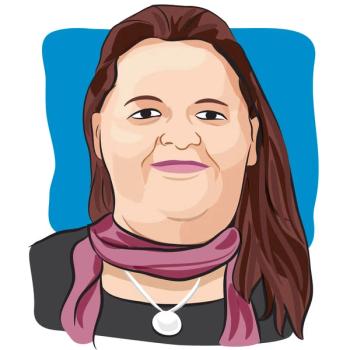
Treatment Overview: ER-positive Breast Cancer
Transcript:
Adam M. Brufsky, MD, PhD: Now we’re going to talk about early-stage breast cancer. ER-positive breast cancer is probably the most common form of breast cancer that we see in our practice. The typical patient that comes in is someone who is 45-50 years old. She has a mammogram. She has some microcalcification. Someone does an ultrasound, and she’s got a 1- or 2-cm breast cancer tumor. They go ahead and do a lumpectomy. And they do a node dissection. It’s node-negative. ER is strongly positive. Then, we decide what to do.
The first thing we obviously do with these people is decide whether they need chemotherapy or not. And, we use genomic tests. Let’s assume that the genomic tests, MammaPrint or Oncotype DX, are negative, low risk. Then, we say, “OK, now what?” We put them on antihormonal therapy. Generally, we’ve always thought of this as benign. But again, you see them a lot. You’re the one on the other end of the line, after I’ve given them the therapy. For premenopausal women on tamoxifen, for example, the big concern everybody has is, “Am I going to get uterine cancer from my tamoxifen?” Do you hear that a lot from people?
Lynn Acierno, BSN, RN, OCN, RN-BC: In the savvy computer people who look up side effects, I do.
Adam M. Brufsky, MD, PhD: They say, “I don’t want tamoxifen, under any circumstance.” And we say, “Generally, for premenopausal women who are still menstruating, they’re not going to get uterine cancer.” Sure, anything can happen, and it has. In our practice, I’ve seen enough people. We all have. But, on the other hand, the vast majority of people will be fine with tamoxifen. But what people do get is vaginal discharge. They get hot flashes. Occasionally, they’ll get blood clots. The big one is cramps. You’ve probably heard that from people?
Lynn Acierno, BSN, RN, OCN, RN-BC: Arthralgias.
Adam M. Brufsky, MD, PhD: Arthralgias, cramps, that sort of thing.
Lynn Acierno, BSN, RN, OCN, RN-BC: We see many women who want to stop because of arthralgias.
Adam M. Brufsky, MD, PhD: Correct. But, the arthralgias are more from the aromatase inhibitors. They are from tamoxifen, too. The other issue occurs in postmenopausal women who get aromatase inhibitors. When I start people with anastrozole, I usually tell them, “You’re going to be on it for a couple of months. You may get it. About 10% of the people get it. For 15% of the people who get it, it’s really bad. If it doesn’t go away, we’ll stop it and try something else.” That’s one of our most common conversations we have. You’ll email me, or call me, and say, “Mrs. ‘X’ has really bad arthralgia. She wants to stop this. What should we do next?”
Lynn Acierno, BSN, RN, OCN, RN-BC: Right.
Adam M. Brufsky, MD, PhD: How do you handle that?
Lynn Acierno, BSN, RN, OCN, RN-BC: We like to give the patient at least a 2-week break to see if the symptoms resolve on their own. If they resolve, we determine that it was probably most likely the aromatase inhibitor. If the symptoms don’t go away, then we have them follow up with their primary care physician to see what else could be going on.
Adam M. Brufsky, MD, PhD: Right.
Lynn Acierno, BSN, RN, OCN, RN-BC: But, we find that most women do very well on another drug in the same family.
Adam M. Brufsky, MD, PhD: Right. That’s really important to say. That’s something which patients don’t realize. There are at least 3 options. There’s anastrozole, which is Arimidex. There is letrozole, which is Femara. And, there is exemestane, which is Aromasin. All 3 are generic, now. The cheapest one, right now, is anastrozole.
The thing is, we can treat with those 3. And, if they don’t do well, those 3, in a postmenopausal woman, we can always give them tamoxifen. So, that’s 4. And, there’s even another one after that, toremifene. (Fareston), which is unfortunately more expensive than tamoxifen because it’s still not generic. But, we have 5 things that we can give people. People don’t realize that they can go through any of the 5. We’ve had people go through all 5, as you know.
Lynn Acierno, BSN, RN, OCN, RN-BC: Right.
Adam M. Brufsky, MD, PhD: Generally, most people will be fine with 1 or 2. We generally tell them, “Don’t give up. There are other things we can do.” Now, if we’ve gone through all 5 and they’re still miserable, and we’ve had people like that, we have to make the determination. What is the true risk for recurrence in this patient versus the side effects? I don’t want people to be miserable for 5 years.
Lynn Acierno, BSN, RN, OCN, RN-BC: Right, and the side effects can be pretty substantial.
Adam M. Brufsky, MD, PhD: Absolutely. People say, “I feel like an old woman.” Do you get that one from people?
Lynn Acierno, BSN, RN, OCN, RN-BC: What I do hear, that I didn’t anticipate, is a lot of people have called in with mood changes.
Adam M. Brufsky, MD, PhD: Yes, there’s some mood changes. Estrogen does have something to do with mood, and you are reducing estrogen from a low level, in postmenopausal, to 0. Even that small drop can cause mood changes, and can lead to depression.
Lynn Acierno, BSN, RN, OCN, RN-BC: That can be pretty substantial, as well.
Adam M. Brufsky, MD, PhD: We’ve had to change people around to other drugs because of that. There’s all of these other things that people don’t really talk about.
Transcript Edited for Clarity





